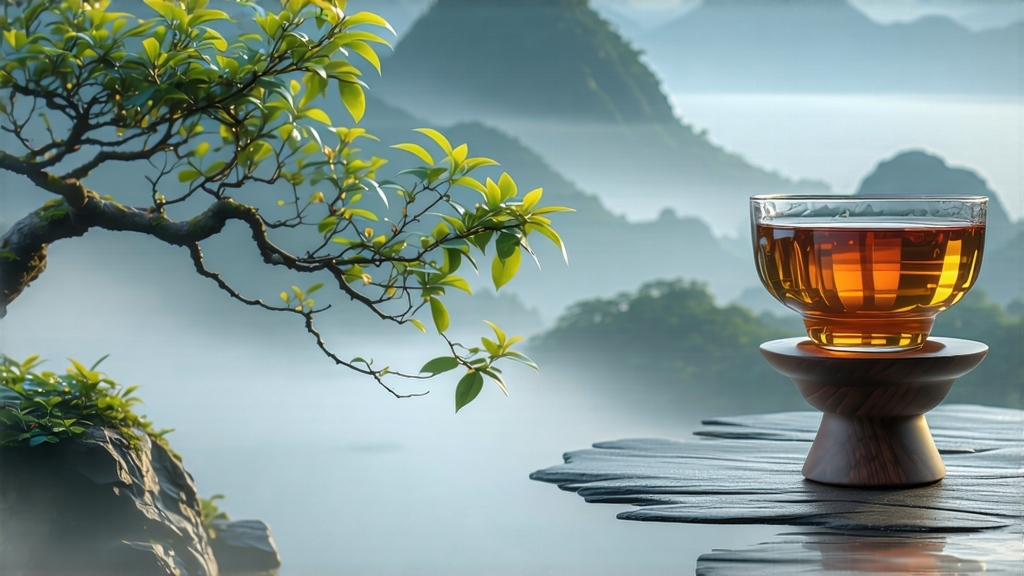
From the granite peaks of Anxi in southern Fujian comes a tea whose name translates as “Iron Goddess of Mercy.” To the Chinese palate, Tieguanyin is more than a beverage; it is liquid incense, a meditation on floral altitude and mineral depth that has traveled unchanged from Qing-dynasty village altars to twenty-first-century specialty cafés in Melbourne, New York, and Nairobi. This essay invites the international reader to walk the entire arc of Tieguanyin—from myth to leaf, from leaf to cup, and from cup to contemplative silence—so that wherever you are, you can brew the mountain rather than merely remember it.
-
Myth and Historical Stratigraphy
Legend places the birth of Tieguanyin in the 1720s, when a poor farmer named Wei Yin ritualistically swept the ruins of a forgotten temple dedicated to Guanyin, the Bodhisattva of Compassion. That night the goddess appeared in a dream, directing him to a hidden shrub glowing behind the altar. Wei transplanted the shrub, cultivated it, and found its infusion ambrosial. The name “Tie” (iron) references the tea’s heavy, dark-green pellets, while “Guanyin” honors the divine hint. Archival tax records from 1736 already list “Guanyin tea” as tribute, proving that myth and commerce merged within a single generation. By the 1870s, Anxi caravans moved Tieguanyin across the South China Sea to Singapore, Penang, and eventually the Chinatowns of San Francisco, embedding the tea inside the global Cantonese diaspora long before the word “specialty” was appended to coffee or tea. -
Micro-Terroir: Why Anxi Tastes Like No Other Place
Anxi County sits on the 25th parallel north, where the Wuyi Mountains taper into subtropical foothills. Daytime temperatures hover around 28 °C, dropping to 18 °C at night; the 10-degree diurnal swing arrests overnight respiration in the leaf, locking in volatile jasmine lactones and geraniol. Granitic soils, rich in potassium and low in nitrogen, force slow growth, concentrating amino acids. Finally, the ubiquitous mountain fog acts as a selective filter, scattering blue light and encouraging the synthesis of catechins that later convert into floral aromatics during oxidation. In short, Anxi tastes like elevation wrapped in stone. -
Cultivar Lineage: Three Brothers and a Cousin
Although all marketed as “Tieguanyin,” four genetically distinct cultivars dominate Anxi gardens:
- Hongxin (Red Heart) Tieguanyin: the original heirloom, low yield, haunting orchid bouquet.
- Lvxin (Green Heart) Tieguanyin: higher yield, greener pellet, brighter cup, the workhorse of modern export.
- Zhangping Shuixian Tieguanyin: a cross with Shuixian, giving a honeyed finish; pressed into square cakes in Zhangping city.
- Maoxie Tieguanyin: “Hairy Crab,” a younger hybrid whose downy leaves yield a creamy body and are often roasted for Vietnamese market.
Each cultivar responds differently to the same crafting protocol, allowing a single mountain to express four aromatic dialects.
- Crafting: The Choreography of Green, Red, and Blue
Western texts often call oolong “semi-fermented,” yet “partial oxidation” is more accurate. Tieguanyin is choreographed across 36 hours and 12 discrete steps:
a. Picking: only the open leaf and the two younger leaves, when the morning dew has evaporated but before 11 a.m.
b. Sun-withering: 20 minutes of soft solar wilting to reduce moisture to 70 %.
c. Indoor withering: leaves rest on bamboo trays for 6 hours; every 40 minutes they are “waked” by gentle tossing to bruise edges.
d. Shaking: the signature step—leaves are tumble-shaken in a rattan drum for 3 minutes, fracturing cell walls and triggering oxidation at margins while veins stay green.
e. Fixing: a 270 °C tumble-roast for 4 minutes halts oxidation at 30–40 %.
f. Rolling: cloth-wrapped leaves are kneaded into tight pellets under mechanical pressure; this shapes the “iron” nugget and forces juices to the surface.
g. First drying: 100 °C for